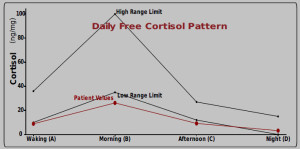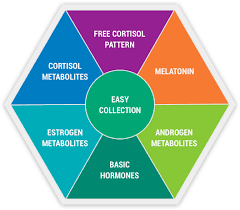“It is estimated that up to 80% of adults in this country experience adrenal fatigue during their lifetime. Yet it is also one of the most under-diagnosed illnesses in the U.S.” (Patti Weissler, L.Ac, R.N., C.SMA, Adrenal Fatigue, Hormone Testing, and Hair Analysis Testing)
Why is this? Some feel that conventional medicine does not consider AFS a “real” disease. In fact, the International Classifications of Disease (ICD), which is the standard classification tool for diseases, illnesses, and conditions used by insurance companies, currently doesn’t even contain a code specifically for AFS. Worse yet, a brief from the Hormone Foundation, which is a division of the Endocrine Society, states that:
“Adrenal Fatigue is not a real medical condition. There are no scientific facts to support the theory that long-term mental, emotional, or physical stress drains the adrenal glands and causes many common symptoms.” (Verne Varona, Adrenal Fatigue Syndrome (AFS) – Hype, Denial and Reality, 2015)
This is hardly the first time that Traditional Chinese Medicine and conventional Western medicine have been at odds – and it surely will not be the last. But we know better, don’t we?
Testing for AFS
In ancient times, practitioners determined if you had Kidney Yang deficiency (AFS) by listening to yours pulse, looking at the tongue, looking at your nails, your ears, your face and a myriad of other things. Today, however, testing for AFS centers around employing sophisticated tests to measure hormone levels within your body, determining if these hormones are active or inactive, and how the levels fluctuate throughout the day. Recalling from the first post on AFS, the adrenal glands are closely tied to the hypothalamus and pituitary glands, as well as the thyroid and the reproductive organs and play a large part in regulating the associated hormone production.
One of the pri mary hormones we watch is cortisol, which normally rises when you get up in the morning, and wanes as the day progresses. If your cortisol is too high, too low, or fluctuating differently than it should, your practitioner needs to know this – as all these variances reflect an imbalance. Oddly enough (not really –it just may seem odd at first blush), additional hormones that need to be checked are your male or female reproductive hormones. “What do sex hormones have to do with the adrenal glands?” you may ask. In short, a lot.
mary hormones we watch is cortisol, which normally rises when you get up in the morning, and wanes as the day progresses. If your cortisol is too high, too low, or fluctuating differently than it should, your practitioner needs to know this – as all these variances reflect an imbalance. Oddly enough (not really –it just may seem odd at first blush), additional hormones that need to be checked are your male or female reproductive hormones. “What do sex hormones have to do with the adrenal glands?” you may ask. In short, a lot.
We all know that women go through menopause at one age or another. In menopause, a woman’s ovaries stop production of estrogen and other female hormones. But what many don’t know, is that when the ovaries stop producing these hormones, the adrenal glands step up to take over this job. This is not a pleasant time in a woman’s life already – but if a woman’s adrenals are stressed, depleted, or in a state of deficiency, menopause is bound to be even more challenging.
Believe it or not, the same situation affects men, too (think: mid-life crisis). In “male menopause” – more correctly called andropause, the same transition occurs, Big T (aka testosterone) becomes little T – and in order to compensate for all the changes that occur as a result of this reduction in testosterone, men get the wild urge to buy a motorcycle, sports car, or go bungee-jumping. But, I digress. Bringing all of this around and back home – the proper test can provide a clear result for your practitioner to determine if your adrenal glands are functioning effectively, or if you are suffering from Adrenal Fatigue.
Until very recently, the go-to test was a saliva test. “What does saliva have to do with hormones?” you may ask. Believe it or not (choose the first, because it is true) both male and female hormones can actually be detected in saliva. Saliva samples were taken multiple times during a 24-hour period and then analyzed for the levels of hormones. Although the test was accurate, the problem was the collection – filling a seemingly small vial with a little spit seems easy enough but it is harder than it looks. You would have to think about all those tasty treats to get the saliva juices flowing and that is really contrary to helping one lose weight if that is an issue.
The DUTCH Test
Enter the DUTCH test. No, it is not from the Netherlands – DUTCH is an acronym standing for Dried Urine Test for Comprehensive Hormones. As one would surmise, this innovative new test uses dried urine. Just pee on 4 or 5 sticks at certain times of the day and night, let them dry, package them up and send them off. Easy-peasy (no pun intended), and bio-available hormone levels are obtained. That’s one benefit. The biggest benefit, though, is that in addition to hormone levels, the DUTCH test also indicates the presence (or lack) of metabolites.
Metabolites are chem icals that are either required for, or produced during, metabolism and are a measurement of hormone production and hormone breakdown. Previous tests like the saliva test could not detect metabolites. This is important because the presence (or lack) of specific metabolites can give your practitioner a more complete (which translates to a better) picture of your overall hormone production. For example, a DUTCH urine steroid hormone profile on someone with low salivary cortisol (they did the spit test) could show normal cortisol production, but high levels of metabolites. This would indicate that you are producing enough cortisol, but it’s just getting broken down into its metabolites very quickly, maybe too quickly. In this case, the speed at which the cortisol is broken down may be the root cause of the adrenal issues and not that you’re not making enough cortisol. This changes the treatment strategy. In addition, there are also some metabolites that are important markers for cancer risk that can only be measured in urine, and not in saliva.
icals that are either required for, or produced during, metabolism and are a measurement of hormone production and hormone breakdown. Previous tests like the saliva test could not detect metabolites. This is important because the presence (or lack) of specific metabolites can give your practitioner a more complete (which translates to a better) picture of your overall hormone production. For example, a DUTCH urine steroid hormone profile on someone with low salivary cortisol (they did the spit test) could show normal cortisol production, but high levels of metabolites. This would indicate that you are producing enough cortisol, but it’s just getting broken down into its metabolites very quickly, maybe too quickly. In this case, the speed at which the cortisol is broken down may be the root cause of the adrenal issues and not that you’re not making enough cortisol. This changes the treatment strategy. In addition, there are also some metabolites that are important markers for cancer risk that can only be measured in urine, and not in saliva.
Many practitioners don’t even know about this test yet – but we do!
Thyroid Panel
An additional test that may need to be performed is a complete Thyroid Blood Panel. As mentioned earlier, the adrenal, thyroid, hypothalamus, pituitary glands, and reproductive organs are very closely tied together. It has also been shown that weakening of any component in this critical axis can lead to weakening of one of the other components. This means that if conventional medicine diagnoses you with a case of hypothyroidism (low thyroid function), the true culprit may actually be Adrenal Fatigue.
Conclusion
So, once we have been diagnosed with a kidney yang deficiency and associated Adrenal Fatigue Syndrome – what can be done to bring our bodies back into balance and to restore our Qi to its optimal level? This will be the subject of our third and final segment in this series on AFS.
In the meantime, to learn more about TCM and Functional Medicine, visit our web page at www.NaturesBalanceAcupunture.com . Call Nature’s Balance Acupuncture and Wellness Center at (815) 788-8383 to learn more, or to schedule your individual wellness assessment.
